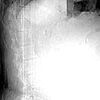Woman With a Protuberant Abdomen
A 69-year-old woman with a protuberant abdomen presents with intermittent, painless vaginal bleeding of 2 weeks' duration. The patient has not seen a physician in years. Her abdominal girth began to increase 8 years ago.

Figure 1

Figure 2
A 69-year-old woman with a protuberant abdomen presents with intermittent, painless vaginal bleeding of 2 weeks' duration. The patient has not seen a physician in years. Her abdominal girth began to increase 8 years ago. She was menopausal at age 52 years. She denies fever, weight loss, and chest pain; she has occasional constipation, which is relieved by over-the-counter medications. She has smoked 2 packs of cigarettes per day since age 21 years and drinks whisky daily in moderate amounts.
Temperature is 35.6°C (96.1°F); heart rate, 131 beats per minute; blood pressure (right arm), 150/ 70 mm Hg; weight, 138 lb; and height, 60 in. There is no lymphadenopathy, cyanosis, or ankle edema. The abdomen is significantly distended, nontender, and dull to percussion.
White blood cell count is 17,130/µL, with 82% polymorphonuclear leukocytes; hemoglobin level is 7 g/dL; platelet count is 538,000/µL; prothrombin time is 16.7 seconds; and partial thromboplastin time is 24.3 seconds. Electrolyte levels and renal and liver function test results are normal. A scout film and CT scan of the abdomen are shown.
Based on the clinical and radiographic findings, what do you suspect?
(Answer on the next page.)

Figure 1

Figure 2
Mucinous cystadenoma
The CT scan showed a large complex mass, suggestive of ovarian origin, that filled the entire pelvis and extended into the abdomen. Further tests revealed a cancer antigen (CA) 19-9 level of 2568 U/mL, a CA 125 level of 172 U/mL, and a carcinoembryonic antigen (CEA) level of 23.6 ng/mL.
An endometrial biopsy was attempted but could not be completed because of the size of the abdomen. Multiple units of packed red blood cells were transfused, and exploratory laparotomy, total abdominal hysterectomy, and bilateral salpingooophorectomy were performed. A 35-lb right ovarian mass was removed.
Pathological examination revealed a mucinous cystadenoma with focal areas of high-grade dysplasia of the epithelium. The mucinous epithelial cells showed a positive staining pattern for CEA, cytokeratin-7, and cytokeratin-20. Endometrioid-type endometrial carcinoma with squamous differentiation was also identified. There was no endocervical invasion, and the lines of resection were free of carcinoma. No regional lymph node involvement was noted during surgery.
The patient recovered uneventfully. At discharge, her weight was 100 lb; she was in stable condition but required gait training because of the significant weight loss.
References:
FOR MORE INFORMATION:
• Ascher SM, Reinhold C. Imaging of cancer of the endometrium. Radiol Clin North Am. 2002;40:563-576.
• Castrillon DH, Lee KR, Nucci MR. Distinction between endometrial and endocervical adenocarcinoma: an immunohistochemical study. Int J Gynecol Pathol. 2002;21:4-10.
• Connor JP, Andrews JI, Anderson B, Buller RE. Computed tomography in endometrial carcinoma. Obstet Gynecol. 2000;95:692-696.
• Seidman JD, Kurman RJ. Pathology of ovarian carcinoma. Hematol Oncol Clin North Am. 2003;17:909-925.